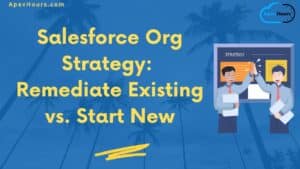In this post we will talk about how to pass Salesforce Certified Integration Architecture Designer Exam? A Salesforce Certified Integration Architecture Designer assesses the integration requirements necessary to design secure, scalable solutions integrating the Salesforce platform. The designer has experience designing and implementing complex integration patterns to various platforms, as well as communicating the solution and design trade-offs to business and technical stakeholders alike.
Who is Salesforce Certified Integration Architecture?
A Salesforce Certified Integration Architecture Designer assesses the integration requirements necessary to design secure, scalable solutions integrating the Salesforce platform. A Integration Architect should have One year of Integration Architecture experience and three to four years of experience on Salesforce platform.
- Has a thorough understanding of Web Services in general and SOAP and REST specifically; understands the basic workings of HTTP/S.
- Understands data migration considerations, design trade-offs, and common ETL tools.
- Understands patterns/mechanisms to secure integrations, such as TLS for HTTP.
- Has experience with common integration patterns used on the Force.com Platform.
About Salesforce Certified Integration Architecture Designer Exam
- Content: 60 multiple-choice/multiple-select questions
- Time allotted to complete the exam: 105 minutes
- Passing Score: 67%
- Registration fee: USD 400.
EXAM OUTLINE
- Salesforce Integration Capabilities: 28%:
- In a given scenario, recommend when to use API-based integrations, such asSOAP, REST, Bulk, Streaming, Canvas, Workflow outbound, APEX (Callouts, @future, etc.) and Lightning Connect to achieve business requirements.
- Compare and contrast the advantages and drawbacks (design trade-offs) of using API-based integrations such as SOAP, REST, Bulk, Streaming, Canvas, Workflow outbound, APEX (Callouts, @future, etc.) and Lightning Connect.
- Salesforce Integration Patterns: 17% :
- Provided an integration scenario, describe requirements and issues that the Architect must consider to select the right pattern (Layer, Timing, Direction, and Volume).
- In a customer scenario containing business requirements, summarize which implementation pattern will achieve those goals.
- Compare and contrast the advantages and drawbacks (design trade-offs) of using various patterns, such as: Remote Process Invocation—Request and Reply, Remote Process Invocation—Fire and Forget, Batch Data Synchronization, Remote Call-In, and UI Update Based on Data Changes
- Enterprise Integration Architecture Concepts: 15% :
- Given a customer scenario containing business requirements for integrating Salesforce with other enterprise back-office systems, recommend the appropriate integration architecture.
- Analyze and determine when and where to use data cleaning, standardization, deduplication, and data transformation as part of data integration.
- Salesforce Integration Testing: 10%
- Given a software development lifecycle scenario, determine the timing, type, and sequence of testing activities that are needed for successful implementation.
- Given an integration scenario, determine the appropriate platform capability needed to meet the testing requirements.
- Integrating with Salesforce Security: 15%
- Given a scenario, determine the appropriate security strategy to meet the customer requirements.
- Tools: 10%
- Given a scenario, determine the appropriate tools to meet the customer requirements.
- Given a scenario, analyze and recommend the appropriate tools by comparing the pros and cons to meet the business requirements.
- Monitoring: 5%
- Given a scenario, identify, isolate, and recommend approaches for integration challenges
Learn Materials for Salesforce Certified Integration Architecture Designer Exam
Here are some comprehensive general resources that are a good starting place for your self paced study.
Technologies and Overall Integration Strategy
- Start with Architect Journey: Integration Architecture Trailmix.
- Check our Apex Hours Integration playlist.
- Integrating with the Force.com Platform :This article provides an overview of the fundamental developer integration points available on the Force.com platform. After reading this article, you will be aware of approaches you could take, and you’ll have enough pointers to more in-depth material to implement your integration.
- UML 2 Sequence Diagrams: An Agile Introduction : UML sequence diagrams model the flow of logic within your system in a visual manner, enabling you to document and validate your logic, and are commonly used for both analysis and design purposes. Sequence diagrams are the most popular UML artifact for dynamic modeling, which focuses on identifying the behavior within your system.
- Catalog of Patterns of Enterprise Application Architecture: Check apex hours Integration pattern blog post for same.
- Outbound messaging in Salesforce.
- Named Credentials overview.
- Salesforce to Salesforce Integration: Learn how to set up Salesforce to Salesforce for communication between your Salesforce organizations.
Integration Solution Tools
- Which API Should I use? Salesforce provides programmatic access to your organization’s information using simple, powerful, and secure application programming interfaces.
- Best practices to avoid excessive SOAP and REST API DML : When developing integration applications using the Force.com SOAP API or REST API, you should make sure your code is as efficient as possible to avoid poor performance or API limit issues due to excessive API calls. See the following best practices for tips on making your integration code as efficient as possible.
- Differences between Salesforce provided WSDL files: Salesforce provides a WSDL (Web Service Description Language) files. They are called “Enterprise WSDL” and “Partner WSDL”.
Security
- Salesforce Certificates and Keys : Salesforce certificates and key pairs are used for signatures that verify a request is coming from your organization.
- Connected App Overview : This webpage provides an introduction to Salesforce Connected Apps and their use to provide application-specific permissions.
- Deep Drive in OAuth Authorization Flows. This article takes an in-depth look at the OAuth 2.0 protocol in the context of Force.com, and is intended for developers and architects with an understanding of security and identity concepts, such as authentication and authorization





Want to subscribe
Hello writter,
Passing Score: 67% means for each of section have 67 % or accumulate result.?
You need overall score as 67% to pass the Salesforce Certified Integration Architecture Designer Exam